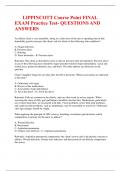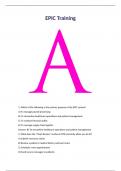LIPPINCOTT Course Point FINAL EXAM Practice Test - QUESTIONS AND ANSWERS An elderly client is very immobile, sitting in a chair most of the day or spending time in bed. Immobility greatly increases the client's risk for which of the following skin conditions? A. Fungal infection B. Pressure ulcers C. Bruising D. Stasis dermatitis - B. Pressure ulcers Rationale: The client as described is most at risk for pressure ulcer development. Pressure ulcers in any of the following areas should be stag ed and interventions begun immediately: sacral and ischial areas, greater trochanteric area, and heels. The other options are distracters to the question. Claire's daughter brings her in today after she fell at her home. Which assessments are indicated at this time? A. Orthostatic vital signs B. Review of her medications C. Assessment of gait and balance D. All of the above - D. All of the above Rationale: Falls are common in the elderly, and can often result in serious injuries. When assessing the cause of falls, gait and balance should be checked first. Medications, particularly use of more than three, are associated with falls. Vision problems, lower limb joint problems, and cardiovascular problems, such as arrhythmias, may be reasonable to search for. Orthostatic vital sign changes should be sought. When applying the principle of ABC (airway, breathing, circulation) prioritization, which complication is priority for the nurse to address? A. Wound infection B. Bacteremia C. Aspiration pneumonia D. Uri nary tract infection - C. Aspiration pneumonia Rationale: Aspiration pneumonia compromises the client's airway and is the priority concern to address. Wound infection, Urinary tract infection, and bacteremia do not directly compromise the airway. The nurse is preparing to conduct an admission assessment on an older adult client. What would be important to do before interviewing this client? A. Make sure the door is not blocked B. Speak in a louder than normal voice C. Reduce or eliminate background no ise D. Turn up the client's hearing aid - C. Reduce or eliminate background noise Rationale: It is essential to reduce or eliminate background noise as much as possible when carrying on conversations. This includes turning off the television or radio in t he client's room and closing the door to reduce sounds of telephones, beepers, alarms, or pagers. Before beginning the interview, it would not be necessary to make sure the door is not blocked or to speak in a louder than normal voice. The scenario does no t say that the client is using a hearing aid. The nurse is conducting a functional assessment of an older adult client. The nurse should focus questions on which area? A. Quality of life B. Activities of daily living C. Recent personal losses D. Feelings about aging - B. Activities of daily living Rationale: A functional assessment is an evaluation of a person's ability to carry out the basic self-care activities of daily living, such as bathing, eating, grooming, and toileting. Issues such as the client 's feelings related to aging, quality of life, and recent personal losses may influence functional ability, but these are not the essence of functional assessment. The nurse is admitting an older male client diagnosed with congestive heart failure. Severa l risk factors for falls have been identified on the admission database. What is the nurse's best action to prevent falls? A. Scan the client's armband before medication administration. B. Use two client identifiers, such as name and date of birth. C. Uti lize safety alarms that are available on the unit. D. Use SBAR and medical terminology for verbal communication. - C. Utilize safety alarms that are available on the unit. Rationale: Using safety alarms, such as bed alarms, can help prevent falls. Using S BAR and medical terminology improve staff communication. Scanning the client's armband and using two client identifiers ensure the nurse identifies the client correctly but do not prevent falls. Which of the following brief screening measures is useful in assessing memory? A. Three -item recall B. Copying intersecting pentagrams C. Spelling "world" backwards D. Serial 7s - A. Three -item recall Rationale: If the client cannot remember three items after 1 minute has passed, then this is a positive result an d indicates a need for further testing. This is part of the "10 -Minute Geriatric Screener." Which of the following represents an age -related change in the lungs? A. Increased speed of expiration B. Increased elastic recoil of lung tissue C. Decreased che st wall compliance D. Increased respiratory muscle strength - C. Decreased chest wall compliance Rationale: The lungs age along with the rest of the body. These changes include decreased lung and chest wall compliance, increased expiratory time, decreased muscle strength and cough, and decreased elastic recoil. A nurse is preparing a health education class for a group of older adult clients at a local senior center. The nurse is focusing on health promotion and disease prevention. Which condition would th e nurse cite as a common cause of infection -related deaths in the elderly? A. Pyelonephritis B. Cellulitis C. Meningitis D. Pneumonia - D. Pneumonia Rationale: Pneumonia is the most common cause of infection -related deaths in the elderly. Pyelonephritis, meningitis, and cellulitis are less common causes. The family members of an elderly client tell the nurse, "He has lost his appetite. He eats very small amounts, and only twice a day." Which suggestion would be most appropriate? A. Counsel them to weigh him daily. B. Recommend nutrient -dense foods. C. Advise them to restrict fluid intake. D. Inform them that he will eat when he is hungry. - B. Recommend nutrient -dense foods. Rationale: Older adults need nutrient -dense foods to ingest enough essential nu trients. Telling them that he will eat when he is hungry is inappropriate. Loss of appetite is a nearly universal cofactor of both physical and mental disease in the elderly. Weighing the client periodically, rather than daily, would be more appropriate. R estricting fluid intake may predispose the client to possible dehydration. In order to let an older adult client establish his or her cultural identity, which statement would be most appropriate for the nurse to make first? A. "I have read books about yo ur culture to help me understand your illness." B. "I will contact your spiritual adviser to help me understand your illness." C. "Tell me your beliefs about the illness you are experiencing." D. "I will make sure you are the only person I speak to about y our illness." - C. "Tell me your beliefs about the illness you are experiencing." Rationale: Experts recommend letting the older adult client establish his or her own cultural identity by exploring cultural explanations of the illness. Inviting the older adult client to share personal beliefs about the illness aligns with the recommended assessment of four key areas of cultural identity. Once the older adult client has established personal cultural beliefs about the illness, the nurse can make the other st atements if appropriate. A son brings his 80 -year-old father into the clinic. The son is concerned because he feels as if his father is growing weak, losing interest in things he used to care about, and no longer coming to dinner on Sundays. The nurse wou ld know that the father is at risk for what? A. Malnutrition B. Dementia C. Depression D. Decreased mobility - C. Depression Rationale: Depression may occur in older adults for various reasons. It is more common in people with multiple chronic health pro blems and in those who have recently suffered the loss of a spouse, friend, family member, or pet. Decisions about moving out of a family home because of increasing care needs may also lead to depressive symptoms. When receiving the shift report, the nurs e should identify which client as being at highest risk for falls? A. 47 -year-old client receiving gastrostomy tube feedings B. 34 -year-old postoperative client on bedrest C. 58 -year-old diagnosed with terminal cancer D. 73 -year-old with confusion and incontinence - D. 73 -year-old with confusion and incontinence Rationale: Confusion and incontinence place this client at highest risk for falls due to the need to frequently go to the bathroom and possibly not calling for help if confused. The client on b edrest should have 2 siderails up and not be at high risk for falls. Gastrostomy tube feedings imply that this client is at higher risk for pressure ulcers and poor wound healing than risk for falls. Cancer itself is not a risk factor for falls. When cond ucting a focused health assessment, the nurse asks questions specifically targeting what?





